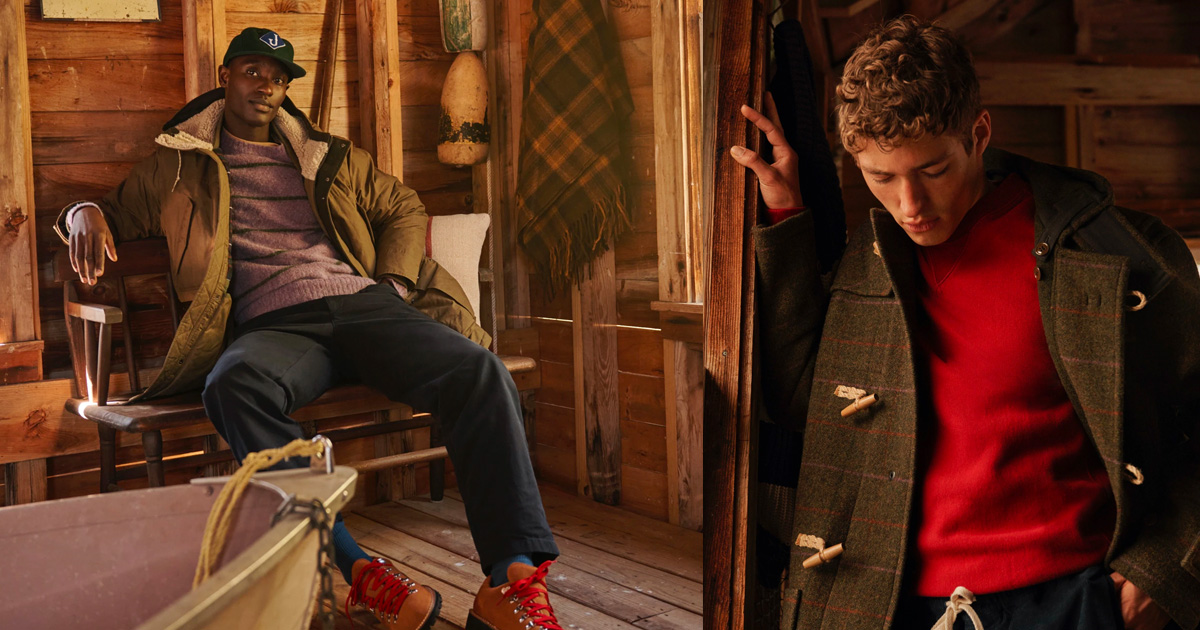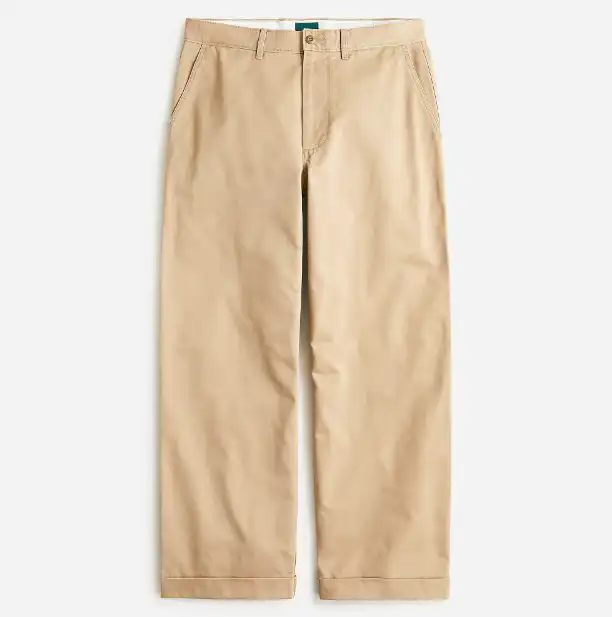You’ve probably shopped at J.Crew before. Need a dress
With changing trends and fast fashion’s chokehold on the masses, J.Crew has seen its fair share of challenges over the last several years… reaching a point where we weren’t sure if it was going to make it.
Thankfully, they made a big move in hopes of saving their brand and signaling a changing of the guard. Brendon Babenzien from menswear brand Noah was appointed J.Crew’s creative director earlier last year with his first collection releasing this past fall.

The question is clear: can Brendon’s revised Americana designs generate excitement around J. Crew again? Can the brand ultimately be saved?
J.Crew history: Where It All Started
The brand we now know as J.Crew was founded in 1947 under the name Popular Merchandise. For context, that same year saw the famous Roswell Incident, the second-ever season of the NBA, and the announcement of the Truman Doctrine marking the beginning of the Cold War.
During its early days, Popular Merchandise operated as a women’s brand specializing in affordable basics for housewives.
By the 1980s, the brand was rapidly growing through a catalog model that caused sales to skyrocket, prompting the company to introduce menswear and rebrand as J.Crew.
They opened a few retail stores while continuing to mail out their catalogs and watched the brand soar to new heights.

J.Crew’s all-American, classic prep aesthetic was at its most popular during the ’80s and ’90s, a period that we return to again and again for fashion inspiration.
From 2006 to 2010, shortly after acquiring Madewell, J.Crew briefly went public before a leveraged buyout by private equity firms took it private again.
The brand struggled to maintain a grip on the womenswear market due to changing trends, the rising popularity of fast fashion, and the shift from brick-and-mortar to online shopping.
In 2018, the brand introduced a more affordable line, J.Crew Mercantile, in hopes of regaining some of its market share.
And sadly, after years of challenges, the brand received what felt like a knockout punch: with the COVID-19 pandemic in full swing, the brand filed for bankruptcy in May of 2020.
People lined the figurative streets to pay their respects to one of their favorite brands, assuming it could pass at a moment’s notice.
Brendon Babenzien Before J.Crew
As J.Crew rose and fell during the 2000s and 2010s, a young designer named Brendon Babenzien sat at the helm at streetwear giant, Supreme.
While Supreme has released a handful of items one could classify as “preppy”, prep is a far cry from the brand’s reputation as a purveyor of clothing for skaters.
Babenzien served as the creative director at Supreme for 14 years before leaving in 2015 to reboot his own label, Noah.
What To Know About Noah, Babenzien’s brand
Noah focuses on elevated, classic Americana with an emphasis on sustainability.
Having visited the SoHo boutique myself, I can say with certainty that the Noah storefront is best experienced in real life. While the brand does a good job showcasing its retail location on Instagram, upon stepping inside, it’s a place that instantly puts you at ease.
Expect to hear classic jazz music coming from the four corners of the room, which is decorated like an old living room with Persian rugs, mirrors on the walls, pre-loved chairs, and dining room tables displaying the brand’s knitwear and tees.

The staff is warm and attentive, giving the store a more nurturing ambiance mirroring Babenzien’s focus on community. (Not to mention the quality of the clothing is, of course, as high as you’d expect.)
Brendon Babenzien’s Noah created a whole new excitement about Americana that only J.Crew and Ralph Lauren had previously been able to accomplish.
When J.Crew appointed Babenzien to be the next creative director for J.Crew, it felt like a logical next step — Brendon had been creating beautiful, preppy clothing for over half a decade by then, building a cult following in the process.
He was exactly the right person to revive a waning fashion empire.
Editor’s note: Enjoying this piece so far? Check out Chris’ newsletter over at The Seasonless.
“New J.Crew”: The Update That The Brand Needed
The first collection of the “New J.Crew” was released in Fall of 2022, making quite a splash on the Internet. Just about every publication from GQ to the New York Times wanted a say on the new collection.
Menswear guys posted fit pics in the new products while style podcasters dedicated entire episodes to them.

The reason that the revival of J.Crew was so notable for so many of us fashion nerds is that it’s the very store that taught us about clothing in the first place.
It’s one of the rare stores where you can source an entire wardrobe full of well-made clothes and not completely break the bank.
Because J.Crew is a mall brand like Gap and Abercrombie, it’s always been one of the most accessible places for people to learn about what clothes look good or bad on their bodies.
We could feel the textures of the pieces and try on several different cuts of pants in one sitting. We could bring a cashmere sweater and a merino wool sweater into a dressing room, try both of them on, and decide what works better for us.
For many of us, J.Crew was a university as much as it was a shopping experience. The sales associates were our professors and the clothing that we could take home at the end of the day was a treat after we finished our homework.
That kind of nostalgia is hard to replicate.
Can Brendon Babenzien Revive J.Crew? What’s Different About The Brand In 2022?
The clothing itself is more of an updated take than a total rebrand.
You won’t walk into a J.Crew and be surprised to find everything unrecognizable. Babenzien is on the record as saying that he didn’t want to reinvent the wheel, but rather revise and refresh the brand’s existing offerings.
He and his team are designing clothing with updated textures and original details but a classic Americana feel. Take this pique collared sweatshirt for example.
While it’s popular to wear a collared shirt under a sweatshirt, the look can appear chunky and unkempt. Babenzien’s team opted to stitch a collar onto a traditional crewneck sweatshirt, giving you the look of layering without the bulk.
Another item that I love is the corduroy collar rugby polo (unfortunately sold out at the time of this article’s publishing, but keep an eye out, it may come back!)
I’ve loved rugby
This one from the new J.Crew features a corduroy collar, reminiscent of the collars on Barbour Jackets, and is perpetually sold out due to its popularity. Perhaps nothing has been more popular from the latest collection than the giant chinos.
At the time that I’m writing this, the giant chinos are $98 (excluded from any promotions) and come in four colors: khaki, green, navy, and black. These pants serve as a symbol of the shifting tides at the fashion titan.
J.Crew was known, almost mockingly, throughout the 2000s and 2010s as a brand where you could get run-of-the-mill slim and skinny-fit chinos and jeans.
Babenzien introducing wide-legged, relaxed-fit pants shows that the brand is committed to maintaining its relevancy and moving with the trends of the times.
A black pair of chinos is sitting in my cart as I write this. I’m battling demons on whether or not to pull the trigger.
Negative Feedback About the New J.Crew
The new J.Crew isn’t without its haters, however.
There’s one common criticism of the latest J.Crew. Popular menswear podcast, Throwing Fits, posted a meme around the same time that the new J.Crew launched saying that everything in the new collection looks like vintage Ralph Lauren. They show several examples.

I ultimately believe this criticism to be unfounded. Anyone with a true understanding of the design process knows that nothing is truly ever “original.”
All new pieces of clothing have reference garments. Everything comes from something else. (And that goes for anything creative: literature, movies, music, clothing, etc.) Menswear guys will find a way to be negative about anything.
J.Crew’s Flagship at 316 Bowery in New York
One of the biggest triumphs of this new era is the flagship store at 316 Bowery in lower Manhattan. It fills the gap that the old J.Crew Liquor Store left in many enthusiasts’ hearts.
This small retail space is dedicated exclusively to the brand’s new products. When I went during opening weekend, the place was bustling with buzz and excitement. I picked up a complimentary matchbook and a coffee from their coffee bar.
The Bowery store gives customers the feeling that they’re in an exclusive club with a cozy vibe achieved by Instagrammable interior design.
If I were a teenager again, learning about clothing for the first time, and I stepped into the new Bowery store, I’d believe I just walked into the Mecca of good taste.
J.Crew is back, everyone!
The once left-for-dead brand has been revived by one of the best designers working in the menswear space today.
Brendon Babenzien was the perfect hire to bring J.Crew’s designs into the 2020s, creating hype and buzz that we haven’t seen around a mall brand since Gap announced its partnership with Kanye West.
While Babenzien’s first collection may sit on the conservative side, I don’t think that he needed to push the envelope too much—that’s not the J.Crew customer.
By refreshing classic pieces and silhouettes while opting to update details and color palettes, he’s created a strong collection of modern-Americana staples.
The best part?
J.Crew is ALWAYS running promotions. Keep an eye on their website because the items that have been on your watchlist? It’ll sell out the second the website introduces a 50% off promo.
You’ve been warned.
Editor’s note: Enjoyed this piece? Check out Chris’ newsletter over at The Seasonless.



